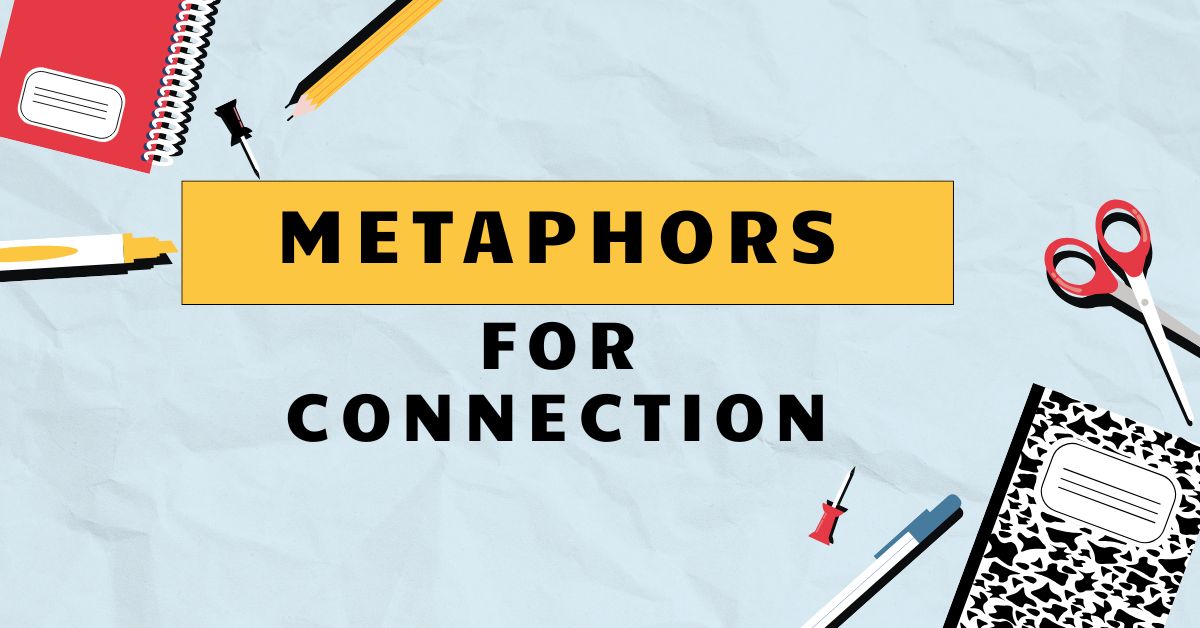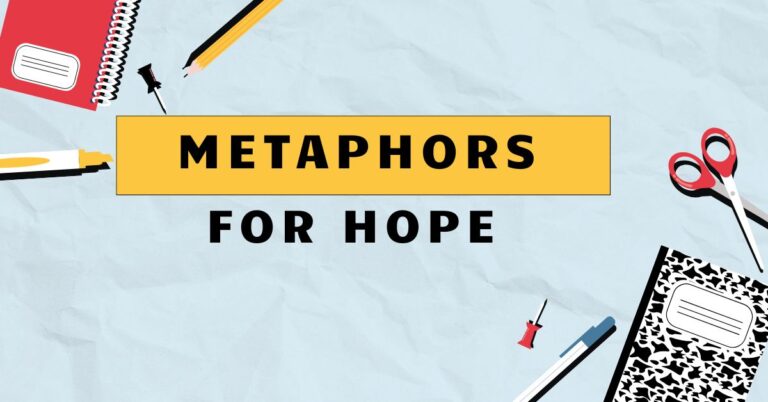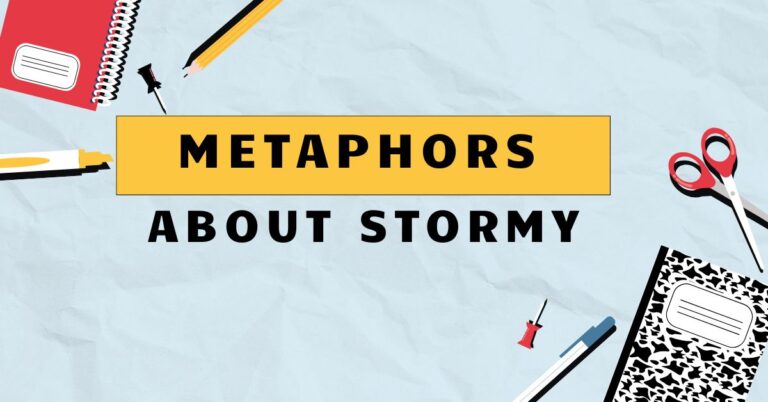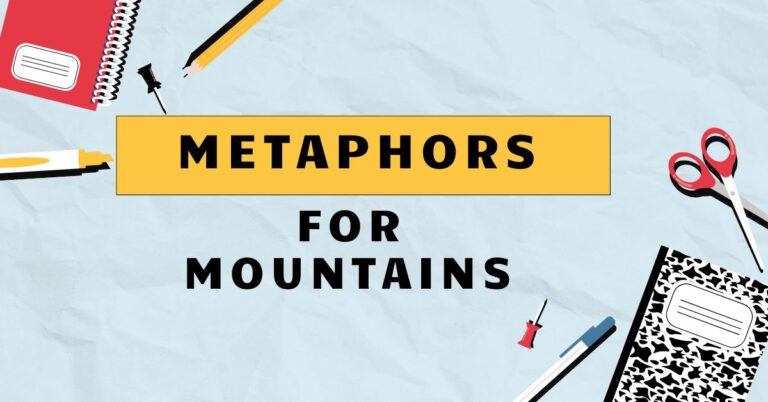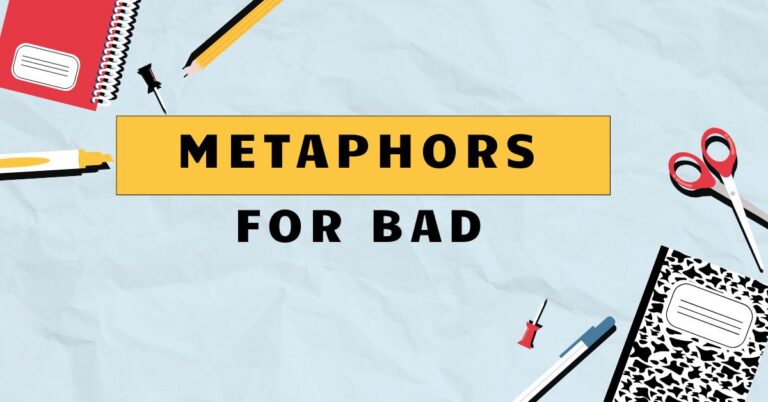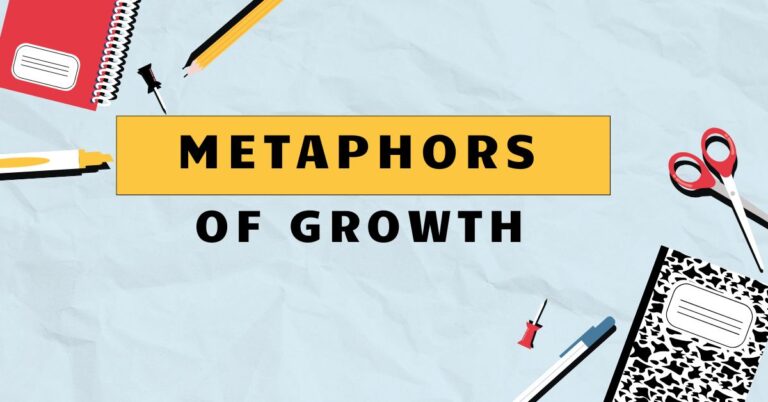43 Metaphors for Connection: Building Bridges with Language
Metaphors are more than just literary devices; they are fundamental to how we understand and communicate complex ideas, particularly those involving abstract concepts like connection. By understanding how metaphors function to describe relationships, we can deepen our comprehension of human interaction and enhance our ability to express nuanced meanings.
This article will explore the various types of metaphors used to describe connection, their structural elements, and how to use them effectively. Whether you’re an English language learner, a student of literature, or simply someone interested in improving your communication skills, this guide will provide you with the tools to master the art of using metaphors for connection.
Table of Contents
- Introduction
- Definition of Metaphors for Connection
- Structural Breakdown
- Types and Categories of Connection Metaphors
- Examples of Metaphors for Connection
- Usage Rules
- Common Mistakes
- Practice Exercises
- Advanced Topics
- FAQ
- Conclusion
Definition of Metaphors for Connection
A metaphor for connection is a figure of speech that describes a relationship or association between two or more entities by comparing it to something else. These metaphors help us understand abstract connections by relating them to more concrete and tangible concepts.
The primary function of these metaphors is to illustrate how things or people are linked, influencing our perception and understanding of those relationships. They are crucial in conveying emotional and social connections, offering a vivid and relatable way to express complex interactions.
Metaphors for connection can be classified based on the type of image they evoke. For instance, abridge metaphorsuggests a way to overcome a divide, while aweb metaphorimplies interconnectedness and interdependence.
The context in which these metaphors are used significantly shapes their meaning. In a political context, “building bridges” might refer to improving diplomatic relations, whereas in a personal context, it could mean fostering understanding between family members.
Understanding these nuances is key to effective communication.
Structural Breakdown
Metaphors for connection, like all metaphors, consist of two primary elements: thetenorand thevehicle. Thetenoris the subject being described (e.g., the relationship between two countries), and thevehicleis the object or concept used to describe the tenor (e.g., a bridge).
The effectiveness of a metaphor depends on the strength of the association between the tenor and the vehicle. A strong metaphor creates a vivid and insightful comparison, while a weak metaphor may be confusing or ineffective.
The structure also involves theground, which refers to the shared characteristics between the tenor and the vehicle. For example, in the metaphor “their friendship is a bridge,” the ground might be the idea of facilitating communication and overcoming obstacles.
Identifying the ground is essential for understanding the intended meaning of the metaphor. Furthermore, thecontextplays a crucial role.
The same metaphor can have different meanings depending on the situation and the audience. Therefore, careful consideration of context is vital when using or interpreting metaphors for connection.
Types and Categories of Connection Metaphors
Metaphors for connection can be categorized based on the type of imagery they employ. Each category evokes different aspects of connection, offering a range of ways to express relationships.
Bridge Metaphors
Bridge metaphors suggest a way to overcome a divide or obstacle, facilitating communication and understanding. They imply a connection that spans a gap, linking two separate entities.
These metaphors are often used to describe efforts to reconcile differences or establish new relationships. The image of a bridge conveys stability, support, and the ability to traverse challenging terrain.
Web Metaphors
Web metaphors emphasize interconnectedness and interdependence. They portray relationships as intricate networks where each element is linked to others.
These metaphors highlight the complexity and mutual influence within a system. Web metaphors are useful for describing social networks, ecosystems, or any situation where multiple elements are intertwined.
Bond Metaphors
Bond metaphors focus on the strength and durability of a connection. They often use images of ropes, chains, or glue to represent the ties that bind people or things together.
These metaphors suggest a strong and lasting connection, emphasizing commitment and loyalty. Bond metaphors are commonly used to describe family relationships, friendships, or professional partnerships.
Path Metaphors
Path metaphors describe connections as journeys or routes that individuals or groups take together. These metaphors emphasize the process of building and maintaining relationships over time.
They often involve concepts of shared goals, mutual progress, and the challenges encountered along the way. Path metaphors are useful for describing collaborations, partnerships, or any relationship that evolves over time.
Container Metaphors
Container metaphors describe connections as spaces that hold or contain relationships. These metaphors often involve images of rooms, boxes, or circles to represent the boundaries and shared space within a connection.
They highlight the sense of belonging, inclusion, and mutual understanding that characterizes strong relationships. Container metaphors are useful for describing communities, teams, or any group where members share a common identity and purpose.
Examples of Metaphors for Connection
The following sections provide examples of each type of connection metaphor, illustrating how they are used in various contexts to convey different aspects of relationships.
Bridge Metaphor Examples
Bridge metaphors are powerful tools for describing how individuals or groups overcome differences to establish connections. They emphasize the act of spanning a gap and creating a pathway for communication and understanding.
The following table provides examples of bridge metaphors used to describe connections:
| Metaphor | Context | Explanation |
|---|---|---|
| “They built bridges with former adversaries.” | Political diplomacy | Indicates efforts to reconcile and establish peaceful relations. |
| “Her empathy was a bridge to understanding his pain.” | Personal relationship | Suggests her empathy facilitated a connection despite his suffering. |
| “Education is the bridge to a better future.” | Social commentary | Implies that education provides a path to improved circumstances. |
| “The translator served as a bridge between cultures.” | Cultural exchange | Highlights the role of the translator in facilitating cross-cultural understanding. |
| “Dialogue is the bridge to resolving conflict.” | Conflict resolution | Suggests that open communication can lead to the resolution of disputes. |
| “The project served as a bridge between research and practical application.” | Scientific research | Indicates the project connected theoretical knowledge with real-world use. |
| “Her kindness was a bridge over troubled waters.” | Personal relationship | Her kindness helped navigate a difficult situation. |
| “Technology can be a bridge to connect people across the globe.” | Technological advancement | Technology helps people connect despite geographical barriers. |
| “Art is a bridge that connects people through shared emotions.” | Artistic expression | Art fosters connection by evoking common feelings. |
| “The agreement was a bridge to future cooperation.” | Business partnership | The agreement set the stage for ongoing collaboration. |
| “Volunteering is a bridge to community involvement.” | Community service | Volunteering allows people to participate in their community. |
| “Mentorship is a bridge to professional growth.” | Professional development | Mentorship facilitates career advancement. |
| “Forgiveness is a bridge to healing.” | Emotional healing | Forgiveness helps individuals recover from emotional wounds. |
| “Music is a bridge that transcends cultural differences.” | Cultural understanding | Music connects people irrespective of their cultural backgrounds. |
| “Patience is a bridge to understanding others’ perspectives.” | Interpersonal skills | Patience enables a deeper comprehension of others’ viewpoints. |
| “Empathy is a bridge to building strong relationships.” | Relationship building | Empathy is crucial for fostering solid connections. |
| “Education is a bridge to breaking the cycle of poverty.” | Social mobility | Education provides opportunities to escape poverty. |
| “Trust is the bridge upon which all relationships are built.” | Trust in relationships | Trust is the foundational element for any healthy relationship. |
| “Communication is a bridge that spans the gap of misunderstanding.” | Effective communication | Communication prevents and resolves misunderstandings. |
| “Laughter is a bridge that connects people in shared joy.” | Shared experiences | Laughter creates a sense of connection through common happiness. |
| “The treaty acted as a bridge between the warring nations.” | International relations | The treaty facilitated peace and normalized relations. |
| “Her experience served as a bridge for new employees.” | Workplace integration | Her experience helped new hires adjust to the company. |
| “The internet is a bridge linking people from all corners of the earth.” | Global connectivity | The internet enables worldwide communication and networking. |
Web Metaphor Examples
Web metaphors illustrate the interconnectedness of elements within a system, emphasizing the mutual influence and interdependence that characterize complex relationships. They highlight the idea that each part is connected to and affects the whole.
The following table provides examples of web metaphors used to describe connections:
| Metaphor | Context | Explanation |
|---|---|---|
| “Their family was a tightly woven web of support.” | Family dynamics | Suggests strong mutual support and interdependence within the family. |
| “The conspiracy was a complex web of deceit.” | Crime and intrigue | Implies a complicated and interconnected network of lies. |
| “The internet is a vast web of information.” | Technology | Highlights the interconnected nature of information online. |
| “The ecosystem is a delicate web of life.” | Environmental science | Emphasizes the interdependence of living organisms in an ecosystem. |
| “The company was caught in a web of legal entanglements.” | Business law | Suggests a complex and difficult situation involving multiple legal issues. |
| “Social media has created a web of global connections.” | Social networking | Highlights the interconnectedness of individuals through social media platforms. |
| “The project became a tangled web of bureaucracy.” | Project management | The project was ensnared in complicated administrative processes. |
| “Her life was a web of commitments and responsibilities.” | Personal life | Her life was characterized by numerous interconnected obligations. |
| “The city is a web of interconnected neighborhoods.” | Urban planning | The city’s neighborhoods are closely linked and interdependent. |
| “The economy is a complex web of supply and demand.” | Economics | The economy is governed by intricate relationships between supply and demand. |
| “The investigation uncovered a web of corruption.” | Law enforcement | The investigation revealed a network of corrupt activities. |
| “Their relationship was a tangled web of emotions.” | Interpersonal relationships | Their relationship was complicated and fraught with mixed feelings. |
| “The system is a web of dependencies.” | Systems analysis | The system relies on numerous interconnected components. |
| “The organization is a web of interconnected departments.” | Organizational structure | The organization’s departments are closely linked and collaborative. |
| “The data formed a complex web of insights.” | Data analysis | The data revealed numerous interconnected patterns and revelations. |
| “Their network was a web of professional contacts.” | Career networking | Their network comprised numerous valuable professional relationships. |
| “The plot was a web of intrigue and suspense.” | Literature | The plot was complex and filled with mystery. |
| “The community is a web of shared interests and values.” | Community building | The community is united by common interests and principles. |
| “The brain is a complex web of neural connections.” | Neuroscience | The brain’s function relies on intricate neural pathways. |
| “The market is a web of economic interactions.” | Market analysis | The market is driven by numerous economic forces and interactions. |
| “The project became a tightly woven web of collaboration.” | Teamwork | The project involved close and effective teamwork. |
| “The city’s infrastructure is a web of essential services.” | Urban development | The city’s essential services are interconnected and critical. |
| “Her influence created a web of followers.” | Influence | Her influence attracted a large group of supporters and admirers. |
Bond Metaphor Examples
Bond metaphors emphasize the strength and durability of connections, often using images of physical ties to represent emotional or social bonds. They convey a sense of commitment, loyalty, and lasting relationships.
The following table provides examples of bond metaphors used to describe connections:
| Metaphor | Context | Explanation |
|---|---|---|
| “Their friendship was a strong bond that could not be broken.” | Friendship | Suggests an unbreakable and enduring connection. |
| “The contract created a legal bond between the companies.” | Business law | Implies a binding agreement with legal obligations. |
| “Family ties are the strongest bonds of all.” | Family relationships | Emphasizes the deep and enduring connections within a family. |
| “Love is the bond that unites them.” | Romantic relationship | Suggests that love is the primary connection between them. |
| “Loyalty is the bond that holds the team together.” | Team dynamics | Highlights the importance of loyalty in maintaining team cohesion. |
| “Trust is the essential bond in any relationship.” | Interpersonal relationships | Emphasizes the foundational role of trust in building strong connections. |
| “Tradition is a bond that connects generations.” | Cultural heritage | Tradition links different generations through shared customs. |
| “Shared experiences forged a strong bond between them.” | Shared experiences | Common experiences created a deep and lasting connection. |
| “The community is held together by a bond of shared values.” | Community cohesion | Shared values unite and strengthen the community. |
| “The partnership was strengthened by a bond of mutual respect.” | Professional partnership | Mutual respect enhanced and fortified the partnership. |
| “The treaty created a bond of peace between the nations.” | International relations | The treaty established a peaceful and cooperative relationship. |
| “Their shared passion formed a strong bond.” | Shared interests | Their common passion created a lasting connection. |
| “The oath symbolized a bond of commitment.” | Commitment | The oath represented a strong pledge of dedication. |
| “The shared struggle created an unbreakable bond.” | Adversity | Overcoming challenges together formed a very strong connection. |
| “Their teamwork formed a strong bond of collaboration.” | Teamwork | Effective teamwork created a cohesive and collaborative relationship. |
| “The shared mission forged an unshakeable bond.” | Shared goals | Working towards a common objective fostered a strong connection. |
| “Their connection was a bond of mutual understanding.” | Understanding | They shared a deep and profound comprehension of each other. |
| “The contract was a strict legal bond.” | Legal agreements | The contract was a stringent and legally binding agreement. |
| “The shared grief created a bond of empathy.” | Empathy | Sharing a common loss fostered a deep sense of empathy. |
| “The community is united by a bond of patriotism.” | Patriotism | Shared love for their country binds the community together. |
| “Their friendship was a bond tested by time.” | Long-term friendship | Their friendship has been proven strong over many years. |
| “The bond between mother and child is unbreakable.” | Family relationships | The connection between a mother and child is inherently strong. |
| “They reinforced the bonds of their alliance.” | Political alliances | They strengthened the commitments of their political partnership. |
Path Metaphor Examples
Path metaphors describe connections as journeys or routes taken together, emphasizing shared progress, goals, and experiences. They highlight the process of building and maintaining relationships over time.
The following table provides examples of path metaphors used to describe connections:
| Metaphor | Context | Explanation |
|---|---|---|
| “They walked the same path in life.” | Life journey | Suggests shared experiences and similar life choices. |
| “Their careers followed parallel paths.” | Professional life | Implies similar trajectories and professional development. |
| “They embarked on a journey together.” | Shared adventure | Highlights a common goal and shared experiences along the way. |
| “Their relationship was a winding path of ups and downs.” | Romantic relationship | Suggests a relationship with many challenges and changes. |
| “They were on the same track towards success.” | Shared ambition | Implies a shared goal and coordinated efforts to achieve it. |
| “Their paths diverged after graduation.” | Life changes | Indicates that they took different directions after a shared experience. |
| “They navigated the journey of parenthood together.” | Parenthood | They shared the experiences and responsibilities of raising children. |
| “Their collaboration was a path to innovation.” | Innovation | Their collaboration led to new ideas and advancements. |
| “Their friendship was a path filled with memories.” | Friendship | Their friendship was rich with shared experiences and memories. |
| “Their lives followed a similar path of hardship.” | Shared struggle | They experienced similar challenges and struggles in their lives. |
| “The project charted a new path for the company.” | Business strategy | The project introduced a new direction and opportunities for the company. |
| “Their journey together was a path to self-discovery.” | Personal growth | Their shared experiences led to personal insights and growth. |
| “The treaty paved the path for future cooperation.” | Diplomacy | The treaty established a framework for ongoing collaboration. |
| “Their love story was a path of unexpected turns.” | Romantic relationship | Their love story had numerous unforeseen events and changes. |
| “They were on a collision course.” | Conflict | They were heading towards a confrontation or disagreement. |
| “Their partnership was a path to mutual success.” | Business partnership | Their partnership led to shared achievements and prosperity. |
| “They forged a new path in the industry.” | Industry leadership | They pioneered innovative approaches and set new standards. |
| “The project was a path of continuous improvement.” | Continuous improvement | The project focused on ongoing enhancements and refinements. |
| “Their lives followed a path of dedication to service.” | Service | Their lives were devoted to helping others and serving the community. |
| “The research opened a new path for scientific exploration.” | Scientific discovery | The research revealed new avenues for scientific inquiry. |
Container Metaphor Examples
Container metaphors describe connections as spaces that hold or contain relationships, emphasizing belonging, inclusion, and shared space. They highlight the sense of community and mutual understanding within a group.
The following table provides examples of container metaphors used to describe connections:
| Metaphor | Context | Explanation |
|---|---|---|
| “They created a safe space for open dialogue.” | Communication | Suggests an environment conducive to honest and respectful communication. |
| “Their home was a haven of warmth and hospitality.” | Family life | Implies a welcoming and comfortable environment. |
| “The team fostered a culture of inclusion.” | Team dynamics | Highlights efforts to create a welcoming and inclusive environment. |
| “The community was a melting pot of cultures.” | Cultural diversity | Suggests a diverse community where different cultures blend together. |
| “Their relationship was a bubble of love and affection.” | Romantic relationship | Implies a close and intimate connection. |
| “The project was a sandbox for innovation.” | Innovation | Suggests an experimental environment where new ideas can be tested. |
| “The conference became a forum for exchanging ideas.” | Professional networking | The conference provided a platform for discussing and sharing ideas. |
| “The school was a nurturing environment for young minds.” | Education | The school offered a supportive and positive setting for learning. |
| “Their friendship created a circle of trust.” | Friendship | Their friendship fostered a secure and confidential relationship. |
| “The organization was a vessel for change.” | Social impact | The organization facilitated and promoted social reform. |
| “The neighborhood was a hub of activity.” | Urban life | The neighborhood was a vibrant and dynamic center of activity. |
| “Their collaboration created a synergy of talents.” | Teamwork | Their collaboration combined their skills to achieve greater results. |
| “The community was a wellspring of support.” | Community support | The community offered abundant and reliable assistance. |
| “Their shared experiences created a reservoir of memories.” | Shared memories | Their experiences together generated a wealth of cherished memories. |
| “The project became a focal point for innovation.” | Innovation | The project became a central hub for new ideas and creativity. |
| “Their relationship was a sanctuary of peace.” | Romantic relationship | Their relationship provided a comforting haven of tranquility. |
| “The platform became an incubator for startups.” | Entrepreneurship | The platform fostered the growth and development of new businesses. |
| “The museum was a repository of cultural heritage.” | Cultural preservation | The museum preserved and displayed significant cultural artifacts. |
| “Their group was a crucible for new ideas.” | Idea generation | Their group facilitated the intense development of groundbreaking concepts. |
| “The city was a melting pot of innovation.” | Urban development | The city combined diverse elements to create innovative solutions. |
Usage Rules
When using metaphors for connection, it’s essential to adhere to certain rules to ensure clarity and effectiveness. First,ensure the metaphor is appropriate for the context.
A metaphor that works well in a personal setting may not be suitable for a formal presentation. Second,avoid mixed metaphors, which occur when you combine two or more inconsistent metaphors.
For example, “They built bridges while also navigating a tangled web” is a mixed metaphor because it combines the bridge and web images in a confusing way. Third,be mindful of your audience.
Choose metaphors that are relatable and understandable to your listeners or readers. Fourth,don’t overuse metaphors.
While they can add color and depth to your language, too many metaphors can become overwhelming and distracting.
Furthermore,consider the cultural implicationsof your metaphors. Some metaphors may have different meanings or connotations in different cultures.
Researching the cultural context can help you avoid unintentional misunderstandings or offense. Finally,ensure the metaphor enhances understanding rather than obscuring it.
The purpose of a metaphor is to clarify complex ideas, so if your metaphor makes the concept more confusing, it’s best to choose a different one. By following these usage rules, you can effectively use metaphors for connection to enrich your communication and deepen your understanding of relationships.
Common Mistakes
One common mistake is usingclichéd metaphors, which are overused and lack impact. For example, “their friendship was a rock” is a common cliché that doesn’t offer a fresh perspective.
Another mistake is using metaphors that aretoo abstract or complex, making them difficult to understand. For instance, “their connection was a quantum entanglement of souls” might be too esoteric for most audiences.Inconsistent imagerycan also lead to confusion.
For example, “their relationship was a bridge built on shaky ground” creates a conflicting image of stability and instability. Finally,misunderstanding the connotationsof a metaphor can lead to unintended meanings.
For example, using a “chain” metaphor to describe a relationship might unintentionally suggest restriction or oppression.
Here are some examples of common mistakes and corrections:
| Incorrect | Correct | Explanation |
|---|---|---|
| “Their team was a well-oiled machine, building bridges to success.” | “Their team was a well-oiled machine, ensuring efficient operation.” OR “They built bridges to connect with new clients.” | Mixed metaphor: combining “well-oiled machine” (efficiency) with “building bridges” (connection) inappropriately. |
| “Their love was a rose, a tangled web of emotions.” | “Their love was a rose, beautiful but with hidden thorns.” OR “Their relationship was a tangled web of emotions.” | Inconsistent imagery: mixing the image of a “rose” with a “tangled web.” |
| “Their connection was a black hole, sucking them into a vortex of despair.” | “Their connection was a deep pit, trapping them in despair.” | Overly dramatic and potentially confusing metaphor. “Black hole” is too abstract. |
| “Their partnership was a rollercoaster, building a solid foundation.” | “Their partnership was a rollercoaster, full of highs and lows.” OR “Their partnership was built on a solid foundation of trust.” | Conflicting imagery: “rollercoaster” suggests instability, while “solid foundation” suggests stability. |
| “Their friendship was a rock in the storm, a vast web of support.” | “Their friendship was a rock in the storm, providing unwavering support.” OR “Their friendship was a vast web of support, always there in times of need.” | Combining “rock in the storm” (stability) with “vast web” (interconnectedness) creates a mixed metaphor. |
Practice Exercises
Test your understanding of metaphors for connection with the following exercises. Identify the type of metaphor used in each sentence and explain its meaning.
Then, rewrite the sentences using different types of connection metaphors.
| Question | Answer |
|---|---|
| 1. Their shared experiences forged an unbreakable bond. | Type: Bond Metaphor. Meaning: Shared experiences created a very strong connection. Rewritten: Their shared experiences built a bridge of understanding. |
| 2. The internet is a vast web of information. | Type: Web Metaphor. Meaning: The internet is an interconnected network of information. Rewritten: The internet is a bridge connecting people to vast amounts of information. |
| 3. They built bridges with former adversaries. | Type: Bridge Metaphor. Meaning: They reconciled and established peaceful relations. Rewritten: They formed strong bonds with former adversaries. |
| 4. Their home was a haven of warmth and hospitality. | Type: Container Metaphor. Meaning: Their home was a welcoming and comfortable environment. Rewritten: Their home was a bond of warmth and hospitality. |
| 5. Their careers followed parallel paths. | Type: Path Metaphor. Meaning: They had similar trajectories and professional development. Rewritten: Their careers formed a strong bond of mutual success. |
| 6. Trust is the essential bond in any relationship. | Type: Bond Metaphor. Meaning: Trust is crucial for building strong connections. Rewritten: Trust is the bridge to a strong and lasting relationship. |
| 7. The community is a melting pot of cultures. | Type: Container Metaphor. Meaning: The community is diverse and cultures blend together. Rewritten: The community built bridges between different cultures. |
| 8. Their relationship was a winding path of ups and downs. | Type: Path Metaphor. Meaning: Their relationship had many challenges and changes. Rewritten: Their relationship was a bond tested by many ups and downs. |
| 9. The team fostered a culture of inclusion. | Type: Container Metaphor. Meaning: The team created a welcoming and inclusive environment. Rewritten: The team built bridges to include everyone. |
| 10. The conspiracy was a complex web of deceit. | Type: Web Metaphor. Meaning: The conspiracy was an interconnected network of lies. Rewritten: The conspiracy formed a strong bond of secrecy among the participants. |
Exercise 2: Fill in the blanks using appropriate metaphors for connection.
| Question | Answer |
|---|---|
| 1. Education is the _______ to a better future. | bridge |
| 2. Their friendship was a _______ that could not be broken. | bond |
| 3. The internet is a _______ of information. | web |
| 4. Their home was a _______ of warmth and hospitality. | haven |
| 5. They walked the same _______ in life. | path |
Advanced Topics
Delving deeper into metaphors for connection involves exploring their cognitive and rhetorical functions. Cognitively, metaphors shape our understanding by mapping abstract concepts onto more concrete ones, influencing how we perceive and reason about relationships.
Rhetorically, they persuade and evoke emotions, making communication more impactful and memorable. Advanced analysis includes examining how different metaphors for connection reflect underlying cultural values and ideologies.
For instance, a culture that values independence might favor path metaphors, while one that emphasizes community might prefer container metaphors. Additionally, exploring the use of extended metaphors—where a single metaphor is developed throughout a text—can reveal intricate patterns of thought and argumentation.
Studying how metaphors evolve over time and across different contexts provides insights into changing social and cultural norms. Finally, analyzing the interplay between different types of metaphors for connection in complex texts can uncover nuanced layers of meaning and interpretation.
Another advanced topic is the study of how metaphors for connection are used in specific fields, such as politics, business, and psychology. In political discourse, metaphors like “building bridges” often frame policy initiatives as efforts to unite disparate groups or achieve common goals.
In business, metaphors like “networking” highlight the importance of building relationships for career advancement and organizational success. In psychology, metaphors like “emotional bonds” help explain attachment theory and the impact of early relationships on mental health.
Analyzing these field-specific uses can reveal how metaphors shape professional practices and influence public perception.
FAQ
Conclusion
Metaphors for connection are powerful tools for understanding and expressing the complex relationships that shape our lives. By mastering the different types of connection metaphors—bridge, web, bond, path, and container—you can enhance your communication skills and deepen your understanding of human interaction.
Remember to use metaphors thoughtfully, considering the context, audience, and cultural implications. Avoid common mistakes such as clichés and mixed metaphors, and always strive for clarity and originality.
Whether you’re writing a novel, giving a presentation, or simply engaging in everyday conversation, metaphors for connection can help you build bridges with language and create meaningful connections with others.

